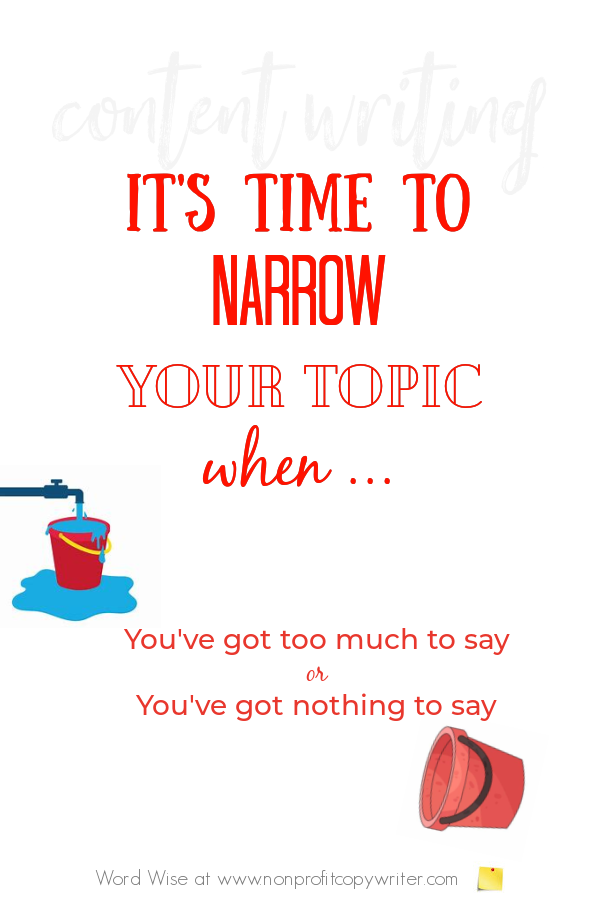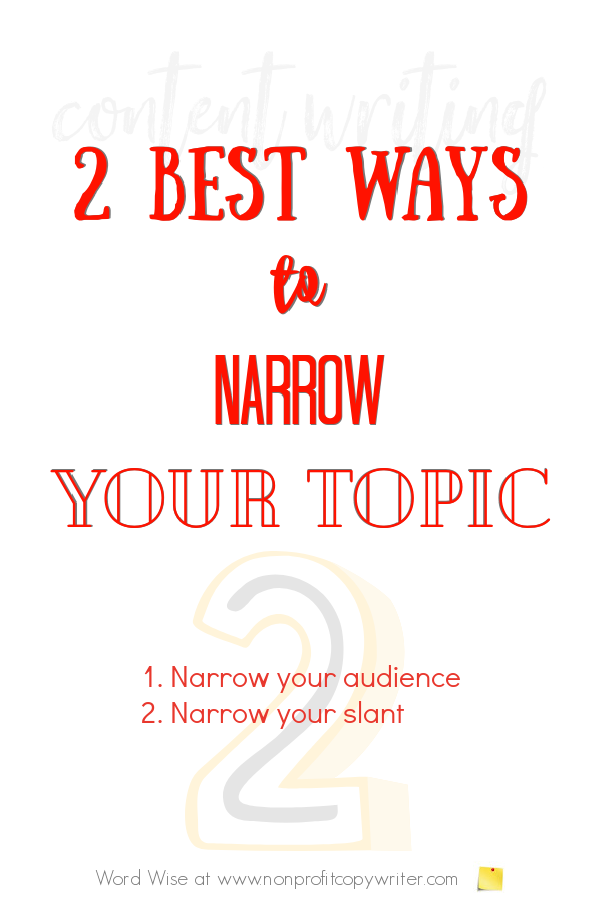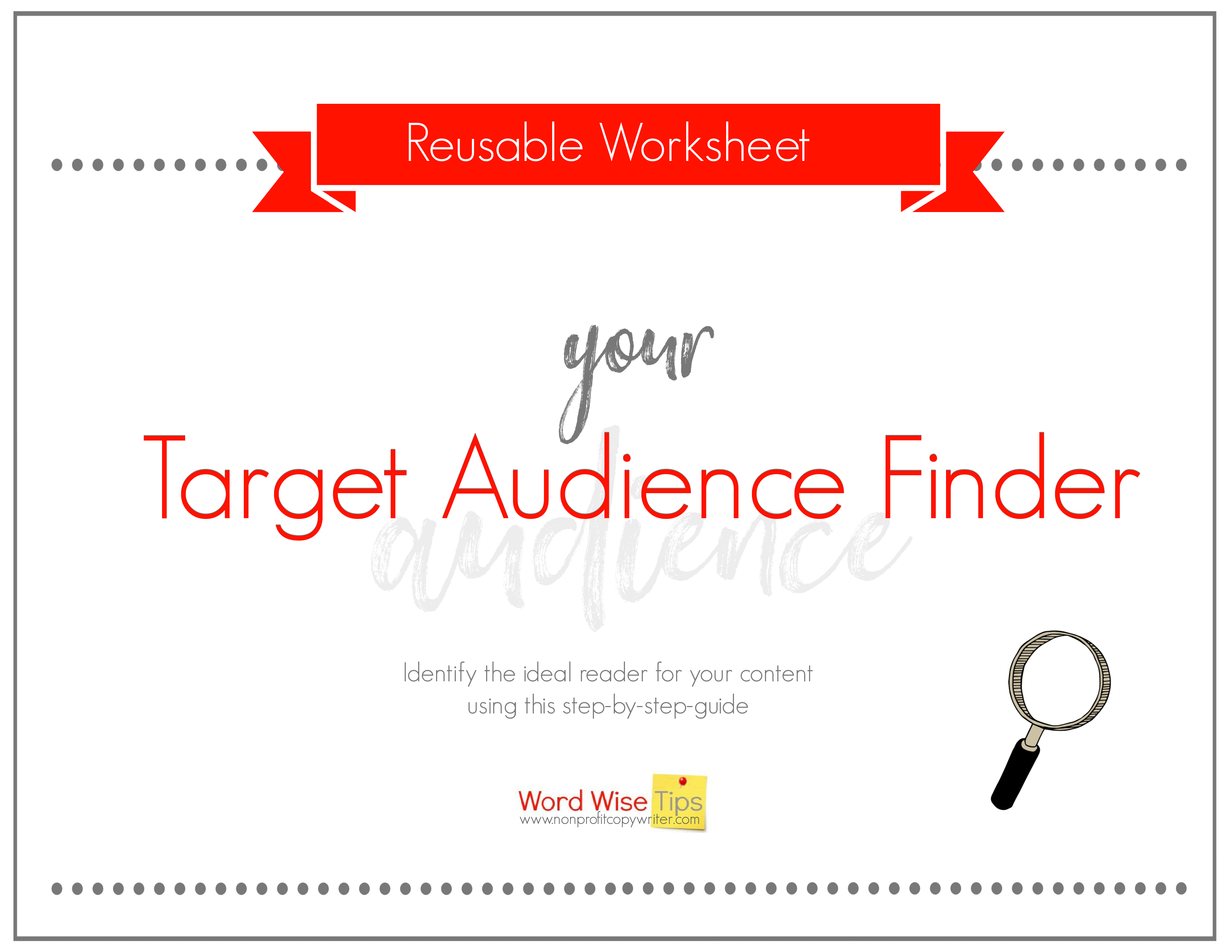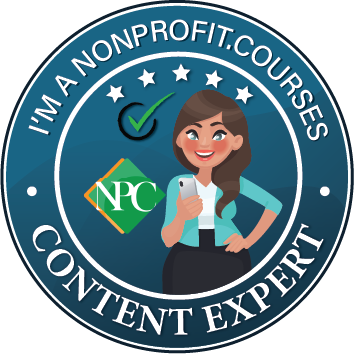Save Time: Get 5 Simple Writing Tips
you can put to use in 10 minutes
The 2 Best Ways to Narrow Your Topic
Award-winning writer Kathy Widenhouse has helped hundreds of nonprofits and writers produce successful content , with 750K+ views for her writing tutorials. She is the author of 9 books. See more of Kathy’s content here.
Updated 11.12.25
“A blog post about everything is a blog post about nothing.” It’s a familiar adage that applies not just to blogs, but to writing an article or a book even a headline.
Put another way: the best content zeroes in on one single thing.
Readers want laser-focused content. When you narrow your topic, you stand out. The proof is in the numbers:
- Articles focused on a single topic receive 2 times more social shares than generalist content (BuzzSumo).
- 50% of online search queries are four words or longer, which shows that readers search for precise information (WordStream).
- Pages that answer specific questions rank for an average of 21 featured snippets (SEMRush).
But when I write, I find I need to narrow my topic for another more selfish reason. It’s not just for readers. It’s for myself.
Focusing on a single topic makes writing easier for me. The writing process is more manageable — and quicker. By narrowing it down, I’ve got clear boundaries for my research.
Plus, I can dive deeper into a narrow topic than a broad topic. Specificity keeps me off rabbit trails and on point.
2 tip-offs that you need to narrow your topic
I’ve learned to gauge when my topic is too broad and needs whittling.
Tip-off #1: I’ve got too much to say
Too much information in too small a space: it’s a sign that my topic is too big.
- I recognize this predicament when my content leans towards generalities.
- I struggle to work in details or offer insights or nail down specifics.
- I find myself summarizing because I’ve got too much ground to cover.
The result is superficial, clichéd, or impersonal fluff. The language is trite and the answers are too pat. My alleged “point” is simply too wide-ranging to zoom in on with any significance.
When I’m overwhelmed with information and platitudes, it’s time to narrow my topic.
Tip-off #2: I don’t know what to say
The second challenge I face when it’s time to narrow my topic is crickets. I can’t get anything down on paper.
Sure, I’ve researched. Maybe I’ve even used ChatGPT. But the cursor keeps blinking on an empty screen. I don’t have anything to say because I don’t have clarity about my topic.
Maybe I’ve been too lazy to stretch my thinking or afraid to dig deeper because it means more work. I find myself regurgitating what others say rather than explaining the content in my own voice.
When I haven’t processed my thoughts long or hard enough to own the content, it’s time to narrow my topic.
Writing gurus offer plenty of good advice for narrowing your topic for your blog post, article, research paper, book, or other content. They give tips like …
- Define your goals
- Generate questions
- Look at the geographical scope
- Study the time frame
- Consider methodology
- Contrast perspectives
Academics may find that list useful. Content writers — not so much. Me? Those options are confusing.
Over the years, I’ve learned two of the best ways to narrow my topic. Since I’m all about making writing simple and accessible, let me share them with you. Maybe these options will help you, too.
1. Narrow your audience
What does this reader need help with? What problem can you solve … what cause can you address … what answers does she need? Research pain points. And on the other side of the coin, what doesn’t she need or want?
Ask and answer those questions and you’ll narrow your topic quickly. Then, write to one specific person about one specific issue. It can be an actual person you know or an imaginary person you create in your mind.
Let’s look at an example. You’re ready to write about kayaking. You’ve kayaked for 20 years so you’ve got plenty of know-how and tips.
But where do you start — with an article titled, “Kayaking”? That’s way too broad of a topic to adequately share about technique, equipment, tours, lessons … even if you chose to write a book.
To narrow your focus, imagine one person you could write to. Just one. And then ask, What is this person’s problem with kayaking? You start with a list like this:
- Beginner kayaking tips for seniors
- Beginner kayaking tips for teenagers
- Beginner kayaking tips for couch potatoes …
You can see how you narrow your topic to groups of people (seniors, teenagers, or couch potatoes). And you can narrow your topic to people with a certain skill level: beginners.
With a list in hand, you choose one reader from your list.
Now, in your mind’s eye, you’re writing to Bertha, the 64-year-old who lives next door. You can clear away all the information that doesn’t apply when teaching Bertha to kayak. And you can use language that suits Bertha.
“If you write for one person, you’ll convince many. Write for many people, you’ll convince one.” It’s a maxim attributed to multiple sources, but regardless of its origin, the idea rings true. Don’t try to write to every person in the world or even every person in your niche.
Go narrow. Write to Bertha. Write to a specific person about a specific problem and offer a solution. You’ll help that one person with their problem — and draw in many others, too.
2. Narrow your slant
A writing slant is one facet of a topic.
To understand this in concrete terms, let’s compare your topic to a person. We’ll name him Adam. This man Adam, as a whole person, represents your “topic.”
However, the people in Adam’s life see him from different angles. Adam is a son, boss, husband, father, grandson, friend, Kiwanis club member, volunteer coach, entrepreneur, nephew, neighbor, investor, homeowner …
Each of his life roles represents a different “slant” on the same “topic.”
Your topic is big and broad — the sum of many possibilities, like the whole person of Adam. You narrow your slant by drilling down on one facet of the topic such as, “Adam, the nephew.”
Then as you write, you put that facet under the microscope and examine it closely. You narrow your topic further to possibilities like, “Adam, the generous nephew” or “Adam, the empathetic oncologist nephew.”
Let’s go back to our kayaking example. You can drill down your broad topic — kayaking — by looking at it from different slants.
- Kayaking on rivers (broad topic)
- Kayaking on rivers in North Carolina (one slant)
- Kayaking on North Carolina’s Catawba River (narrower slant)
- Freestyle kayaking on North Carolina’s Catawba River (even narrower slant)
The more specific, the better. “Dig deep into the story, not wide,” says “America’s Writing Coach” Roy Peter Clark, author of Writing Tools. “The deeper you go, the more universal it becomes.”
Narrow your topic with a simple template
Narrow your topic by narrowing your audience to one person … or by narrowing your slant to one small facet of the whole. Or both.
This simple template can help:
My content will help (target audience) to (outcome).
For example …
My article will help new writers to narrow their topic in 2 easy ways.
Try it. Whether you’re starting a new piece of content or struggling to get clarity with a rough draft.
I bet that you, too, will find yourself asking Bertha what she wants to know about kayaking.
More about Topic and Slant
How to Write An Article: Get Started With These 12 Steps ...
The Foolproof Article Formula I’ve Used to Write 1,000+ Articles ...
Top Article Writing Tip: the One-Point Rule ...
How to Choose an Article Topic...
How to Test an Article Idea ...
Choose a Story Angle Using These 3 Tips ...
How to Write an Outline for your Article ...
Writing Articles Tips on our Pinterest board ...
Return from The 2 Best Ways to Narrow Your Topic to Nonprofit Copywriter home
As an Amazon Associate I earn from qualifying purchases.
Share This Page

Named to 2022 Writer's Digest list
BEST GENRE/NICHE WRITING WEBSITE


Stop Wasting Time!
Grab your exclusive FREE guide, "5 Simple Writing Tips You Can Put to Use in 10 Minutes or Less"














